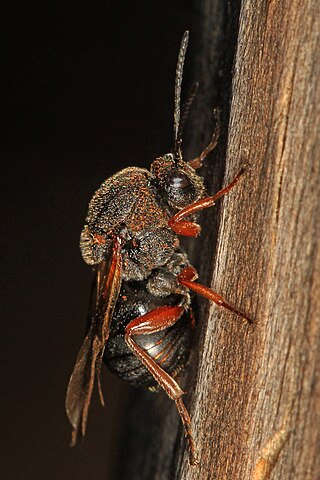
Gall wasps, also traditionally calledgallflies, are hymenopterans of the family Cynipidae in the wasp superfamily Cynipoidea. Their common name comes from the galls they induce on plants for larval development. About 1,300 species of this generally very small creature are known worldwide, with about 360 species of 36 different genera in Europe and some 800 species in North America.

Oak apple or oak gall is the common name for a large, round, vaguely apple-like gall commonly found on many species of oak. Oak apples range in size from 2 to 4 centimetres in diameter and are caused by chemicals injected by the larva of certain kinds of gall wasp in the family Cynipidae.

Andricus kollari, also known as the marble gall wasp, is a parthenogenetic species of wasp which causes the formation of marble galls on oak trees. Synonyms for the species include Cynips kollari, Andricus quercusgemmae, A. minor, A. indigenus and A. circulans.

Andricus foecundatrix is a parthenogenetic gall wasp which lays a single egg within a leaf bud, using its ovipositor, to produce a gall known as an oak artichoke gall, oak hop gall, larch-cone gall or hop strobile The gall develops as a chemically induced distortion of leaf axillary or terminal buds on pedunculate oak or sessile oak trees. The larva lives inside a smaller hard casing inside the artichoke and this is released in autumn. The asexual wasp emerges in spring and lays her eggs in the oak catkins. These develop into small oval galls which produce the sexual generation of wasps. A yew artichoke gall caused by the fly Taxomyia taxi also exists, but is unrelated to the oak-borne species. Previous names or synonyms for the species A. fecundator are A. fecundatrix, A. pilosus, A. foecundatrix, A. gemmarum, A. gemmae, A. gemmaequercus, A. gemmaecinaraeformis and A. quercusgemmae.

Andricus is a genus of oak gall wasps in the family Cynipidae.

Andricus quercuscalifornicus, or the California gall wasp, is a small wasp species that induces oak apple galls on white oaks, primarily the valley oak but also other species such as Quercus berberidifolia. The California gall wasp is considered an ecosystem engineer, capable of manipulating the growth of galls for their own development. It is found from Washington, Oregon, and California to northern regions of Mexico. Often multiple wasps in different life stages occupy the same gall. The induced galls help establish complex insect communities, promoting the diversification in niche differentiation. Furthermore, the adaptive value of these galls could be attributed their ecological benefits such as nutrition, provision of microenvironment, and enemy avoidance.

Andricus kingi, the red cone gall wasp, is a species of gall wasp in the family Cynipidae.

Andricus crystallinus, also known as the crystalline gall wasp, is a species of gall-forming wasp in the genus Andricus. Its galls are pink and covered in hairs that are white, red, or brown. These galls are often massed together in clumps that can cover the underside of leaves. Individual galls are 12-14 mm high, 7 mm across, and have a single chamber for larvae. The unisexual female generation emerges in late winter, and the bisexual generation of males and females emerges in March. They are found in all species of oaks in California.

Andricus parmula, also known as the disc gall wasp, is a species of gall-forming wasp in the genus Andricus. It induces galls in a wide selection of oak species, especially white oaks, and including hybrids. The galls are disc-shaped, up to 3 mm in diameter, and pale with red streaking. Adult females emerge in April. The galls induced by A. parmula superficially resemble the galls of Andricus gigas,Andricus viscidus, and newly identified species called the "plate gall wasp" and the "orange-cap gall wasp" by Richard Russo. Galls induced by this wasp have been documented in Oregon and California on the Pacific coast of North America.

Andricus gigas, also known as the saucer gall wasp, is a species of gall-forming wasp in the genus Andricus. It induces galls on the leaves of scrub oaks, blue oaks, and Engelmann oaks. The galls produced by its all-female generation, which emerges in winter, are 3-4 mm wide, circular with raised edges. They are red, pink, brown, or purple. The larval chamber exists as a raised bump in the gall's center. The bisexual generation produces galls that are brown and cone-shaped.

Andricus pattersonae, also known as the plate gall wasp, is a species of gall-forming wasp in the genus Andricus. Their hosts are among the white oaks grouping of oaks, with blue oak being common.
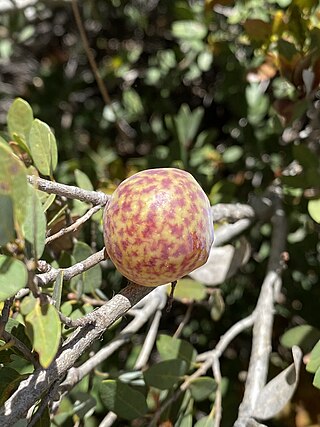
Trichoteras vacciniifoliae, formerly Andricus vacciniifoliae, the golden oak apple wasp, is a species of gall-forming hymenopteran. The wasp creates a stem gall on host plants, namely huckleberry oaks and canyon live oaks. Andricus vacciniifoliae is native to the west coast of North America. Because of their colorful appearance and location on the plant, the galls are often mistaken for fruit. The larval chamber is at the center of the gall, connected to the husk by slender, radiating fibers.
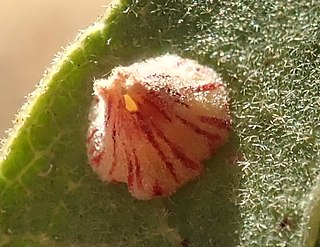
Andricus atrimentus, also known as the striped volcano gall wasp, is a species of gall-forming wasp in the genus Andricus. It induces galls on blue oak leaves. Like other oak gall wasps, it has two generations: a bisexual generation, and a parthenogenic female generation. The bisexual generation produces round, 3–4 millimetres (0.12–0.16 in) galls in spring that start as green or pink, and then turn brown. The unisexual generation produces conical, 4–4 millimetres (0.16–0.16 in) galls in summer that are pale with red stripes.
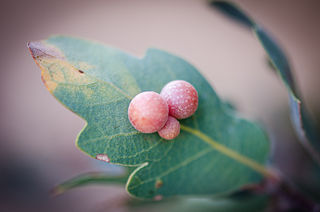
Andricus brunneus, also known as the clustered gall wasp, is a species of gall-forming wasp in the genus Andricus. It lives along the Pacific Coast of North America. Only females of this species are known. Adults are brown or reddish-brown and about 3 millimetres (0.12 in) long. It induces round galls on the leaves of white oaks, especially blue oaks. These galls are usually found in clusters, reddish to light brown, and about 6 millimetres (0.24 in) in diameter. Each holds a single larval chamber, from which adult females emerge in autumn.

Andricus bakkeri, also known as the pinched leaf gall wasp, is a relatively uncommon species of gall-inducing hymenopteran. They produce pink leaf galls on Oregon oaks and scrub oaks. The distribution of this wasp is California and Oregon in North America.

Trichoteras is a genus of gall-inducing Hymenopteran that has several species formerly classed as Andricus. Trichoteras characteristics include antennae with 10 flagellomeres. An entomologist writing in 2018 stated that "is questionable that Heteroecus and Trichoteras should be synonymized with Andricus" in regard to a proposed taxonomic reorganization of 2002. Ronald A. Russo in Plant Galls of the Western United States moves species like the golden oak apple wasp from Andricus to Trichoteras, while acknowledging the previously accepted binomials. William Harris Ashmead first defined this genus in 1897.

Andricus stellaris, the sunburst gall wasp, is a fairly common species of cynipid wasp that produces galls on blue oaks and Oregon oaks on the Pacific coast of North America. The wasp oviposits on the underside of leaves, between the lateral veins; the larval chamber is the brightly colored spot at the center of the gall.
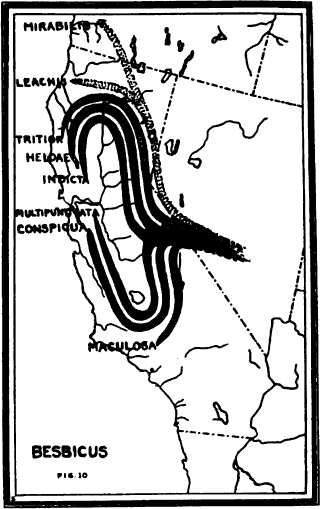
Besbicus is a genus of gall-inducing cynipid wasp found in North America. Several species now classed as Besbicus were formerly considered to be a part of the genus Cynips. Besbicus was originally described as a subgenus by Alfred Kinsey in 1929. Circa 2010, one group of entomologists noted that it was "possible that the nearctic genera Antron and Besbicus were erroneously synonymized to Cynips".

Besbicus conspicuus, formerly Cynips conspicuus, also known as the fuzzy gall wasp, is a common species of cynipid wasp that induces globular stem galls on white oak trees on the west coast of North America. This gall is solid but for the central larval chamber. After the wasp emerges, beetles sometimes chew through the husk to consume the tissue inside. Besbicus conspicuus galls are sometimes mistaken for Disholcaspis washingtonensis galls. This wasp is found west of the Sierra Nevada range in California in North America.
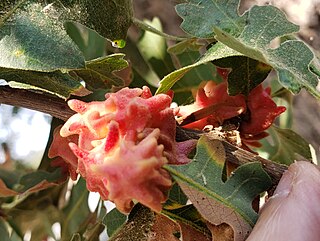
Besbicus heldae, formerly Cynips heldae, also known as the thorny gall wasp or thorn gall wasp, is an uncommon species of cynipid wasp that induces bud galls on Oregon oak and valley oak trees on the west coast of North America. Fresh gall are rose pink, measure 6–16 mm in diameter, and have a "mealy-granular" surface and possibly overlapping, disorderly looking "spikes". Galls are detachable and turn brown as they age. This gall superficially resembles the galls induced by Burnettweldia corallina or Cynips quercusechinus.




















